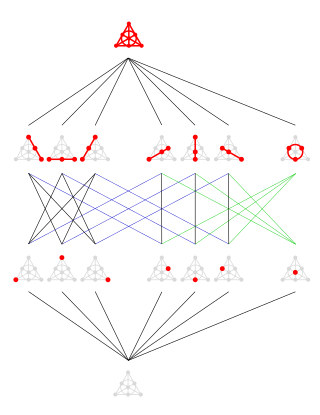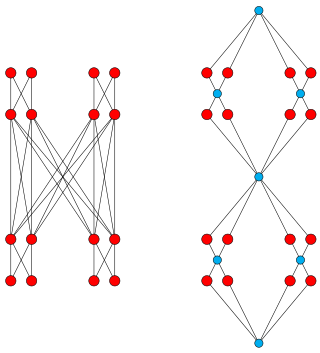
In mathematics, an equivalence relation is a binary relation that is reflexive, symmetric and transitive. The equipollence relation between line segments in geometry is a common example of an equivalence relation.
In mathematics, a total order or linear order is a partial order in which any two elements are comparable. That is, a total order is a binary relation on some set , which satisfies the following for all and in :
- (reflexive).
- If and then (transitive).
- If and then (antisymmetric).
- or .
In combinatorics, a branch of mathematics, a matroid is a structure that abstracts and generalizes the notion of linear independence in vector spaces. There are many equivalent ways to define a matroid axiomatically, the most significant being in terms of: independent sets; bases or circuits; rank functions; closure operators; and closed sets or flats. In the language of partially ordered sets, a finite simple matroid is equivalent to a geometric lattice.
In mathematics, a modular form is a (complex) analytic function on the upper half-plane that satisfies:

In mathematics, a partition of a set is a grouping of its elements into non-empty subsets, in such a way that every element is included in exactly one subset.
In mathematics, in the area of order theory, an antichain is a subset of a partially ordered set such that any two distinct elements in the subset are incomparable.
This is a glossary of some terms used in various branches of mathematics that are related to the fields of order, lattice, and domain theory. Note that there is a structured list of order topics available as well. Other helpful resources might be the following overview articles:
A lattice is an abstract structure studied in the mathematical subdisciplines of order theory and abstract algebra. It consists of a partially ordered set in which every pair of elements has a unique supremum and a unique infimum. An example is given by the power set of a set, partially ordered by inclusion, for which the supremum is the union and the infimum is the intersection. Another example is given by the natural numbers, partially ordered by divisibility, for which the supremum is the least common multiple and the infimum is the greatest common divisor.
In mathematics, a closure operator on a set S is a function :{\mathcal {P}}(S)\rightarrow {\mathcal {P}}(S)} from the power set of S to itself that satisfies the following conditions for all sets

In mathematics, an antimatroid is a formal system that describes processes in which a set is built up by including elements one at a time, and in which an element, once available for inclusion, remains available until it is included. Antimatroids are commonly axiomatized in two equivalent ways, either as a set system modeling the possible states of such a process, or as a formal language modeling the different sequences in which elements may be included. Dilworth (1940) was the first to study antimatroids, using yet another axiomatization based on lattice theory, and they have been frequently rediscovered in other contexts.

In the mathematical discipline of order theory, a complemented lattice is a bounded lattice, in which every element a has a complement, i.e. an element b satisfying a ∨ b = 1 and a ∧ b = 0. Complements need not be unique.
In the mathematical field of order theory, an element a of a partially ordered set with least element 0 is an atom if 0 < a and there is no x such that 0 < x < a.

In the branch of mathematics called order theory, a modular lattice is a lattice that satisfies the following self-dual condition,

In mathematics, in the branch of combinatorics, a graded poset is a partially-ordered set (poset) P equipped with a rank functionρ from P to the set N of all natural numbers. ρ must satisfy the following two properties:
In mathematics, two objects, especially systems of axioms or semantics for them, are called cryptomorphic if they are equivalent but not obviously equivalent. In particular, two definitions or axiomatizations of the same object are "cryptomorphic" if it is not obvious that they define the same object. Examples of cryptomorphic definitions abound in matroid theory and others can be found elsewhere, e.g., in group theory the definition of a group by a single operation of division, which is not obviously equivalent to the usual three "operations" of identity element, inverse, and multiplication.
Boolean algebra is a mathematically rich branch of abstract algebra. Stanford Encyclopaedia of Philosophy defines Boolean algebra as 'the algebra of two-valued logic with only sentential connectives, or equivalently of algebras of sets under union and complementation.' Just as group theory deals with groups, and linear algebra with vector spaces, Boolean algebras are models of the equational theory of the two values 0 and 1. Common to Boolean algebras, groups, and vector spaces is the notion of an algebraic structure, a set closed under some operations satisfying certain equations.
In mathematics, the congruence lattice problem asks whether every algebraic distributive lattice is isomorphic to the congruence lattice of some other lattice. The problem was posed by Robert P. Dilworth, and for many years it was one of the most famous and long-standing open problems in lattice theory; it had a deep impact on the development of lattice theory itself. The conjecture that every distributive lattice is a congruence lattice is true for all distributive lattices with at most ℵ1 compact elements, but F. Wehrung provided a counterexample for distributive lattices with ℵ2 compact elements using a construction based on Kuratowski's free set theorem.

In mathematics, specifically order theory, the Dedekind–MacNeille completion of a partially ordered set is the smallest complete lattice that contains it. It is named after Holbrook Mann MacNeille whose 1937 paper first defined and constructed it, and after Richard Dedekind because its construction generalizes the Dedekind cuts used by Dedekind to construct the real numbers from the rational numbers. It is also called the completion by cuts or normal completion.
In the mathematics of matroids and lattices, a geometric lattice is a finite atomistic semimodular lattice, and a matroid lattice is an atomistic semimodular lattice without the assumption of finiteness. Geometric lattices and matroid lattices, respectively, form the lattices of flats of finite, or finite and infinite, matroids, and every geometric or matroid lattice comes from a matroid in this way.
In mathematics, continuous geometry is an analogue of complex projective geometry introduced by von Neumann, where instead of the dimension of a subspace being in a discrete set , it can be an element of the unit interval . Von Neumann was motivated by his discovery of von Neumann algebras with a dimension function taking a continuous range of dimensions, and the first example of a continuous geometry other than projective space was the projections of the hyperfinite type II factor.







